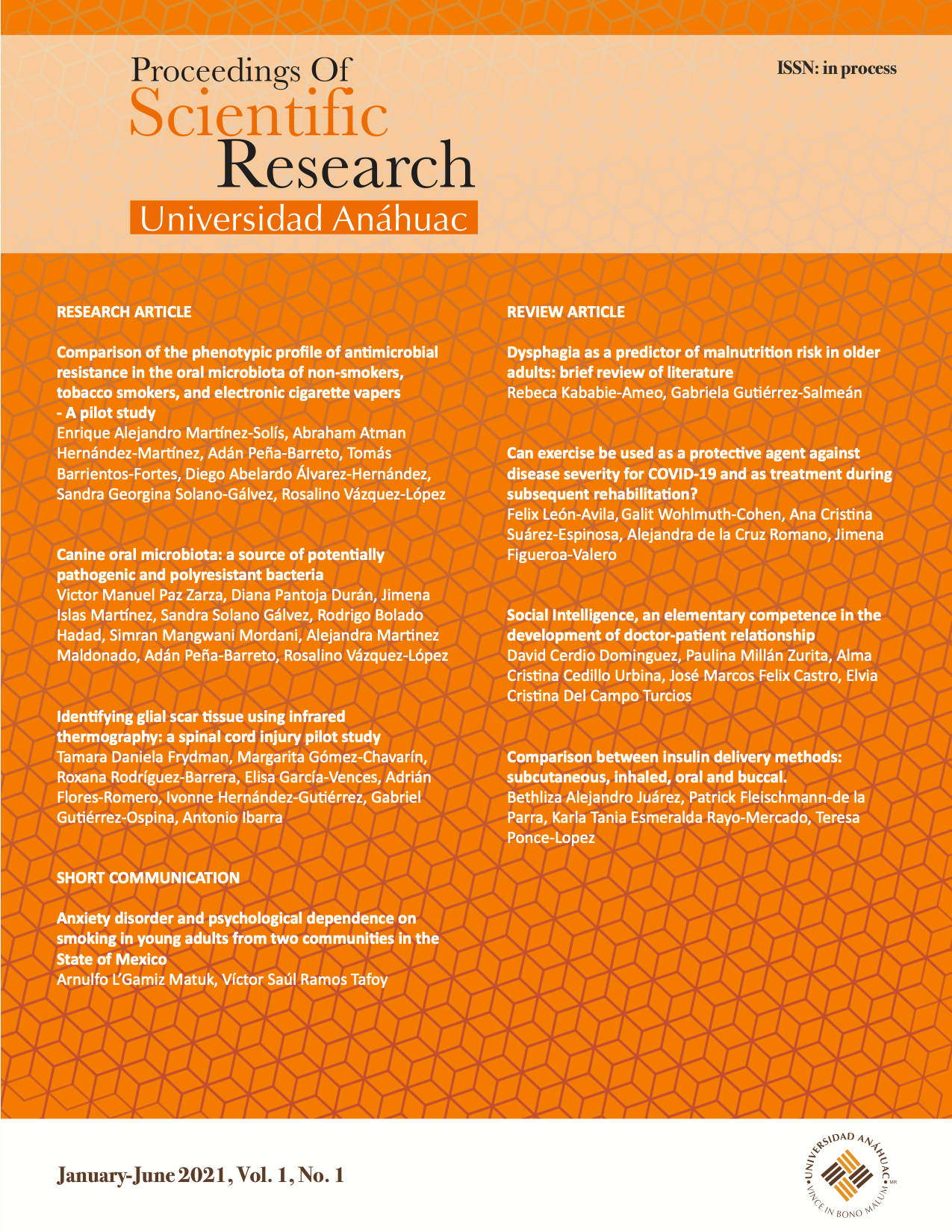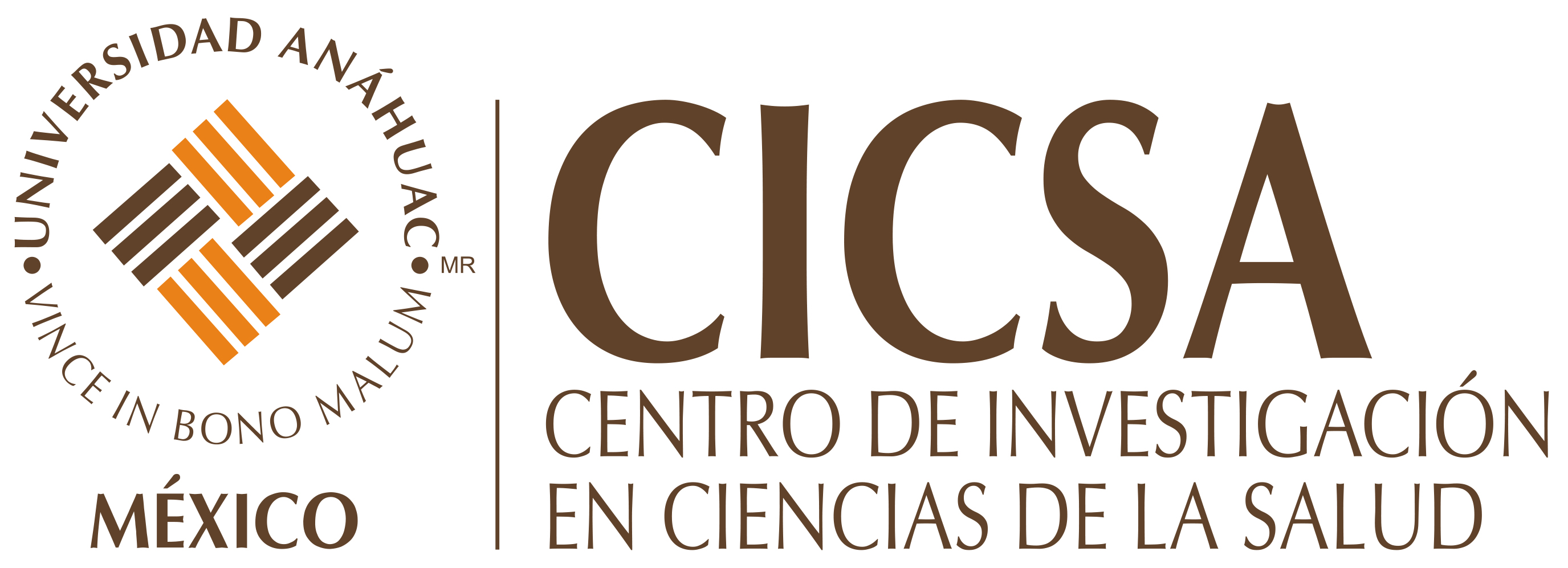Dysphagia as a predictor of malnutrition risk in older adults: a brief review of literature
DOI:
https://doi.org/10.36105/psrua.2021v1n1.05Palabras clave:
dysphagia, elderly, malnutrition, frailty, nutritional supportResumen
Se conoce como disfagia a cualquier alteración en el proceso de la deglución que afecta la capacidad para ingerir alimentos y bebidas, presentándose con una frecuencia del 30 al 40% en pacientes hospitalizados. En el adulto mayor es de gran relevancia por su asociación con el desarrollo de fragilidad, desnutrición y el alto riesgo de morbi-mortalidad. Se ha propuesto un conjunto de factores que contribuyen al desarrollo de la misma como las alteraciones anatómicas y fisiológicas, patologías neurológicas, fármacos y sarcopenia. Es por ello que el soporte nutricional resulta de vital importancia con el fin de evitar el riesgo de broncoaspiración y desnutrición que, a su vez, contribuyen al desarrollo de disfagia.
Descargas
Referencias
2. Sura L, Madhavan A, Carnaby G, et al. Dysphagia in the elderly: management and nutritional considerations. Clin Interv Aging. [Internet]. 2012;7:287–98. https://doi.org/10.2147/CIA.S23404
3. Tagliaferri S, Lauretani F, Pelá G, et al. The risk of dysphagia is associated with malnutrition and poor functional outcomes in a large population of outpatient older individuals. Clin Nutr. [Internet]. 2019;38(6):2684-9. https://doi.org/10.1016/j.clnu.2018.11.022
4. Warnecke T, Dziewas R, Wirth R, et al. Dysphagia from a neurogeriatric point of view. Z Gerontol Geriat. [Internet]. 2019;52(4):330-5.
5. Jardine M, Miles A, Allen J. Dysphagia Onset in Older Adults during Unrelated Hospital Admission: Quantitative Videofluoroscopic Measures. Geriatrics. [Internet]. 2018;3(4):1–11. https://doi.org/10.3390/geriatrics3040066
6. Panebianco M, Marchese-Ragona R, Masiero S, et al. Dysphagia in neurological diseases: a literature review. Neurol Sci. [Internet].2020. https://doi.org/10.1007/s10072-020-04495-2
7. Ponce M, Garrigues V, Ortiz V, Ponce J. Trastornos de la deglución: un reto para el gastroenterólogo. Gastroenterol Hepatol. [Internet]. 2007;30(8):487–97. Disponible en:
https://pdfs.semanticscholar.org/b187/1a16771eadcfc9ac95232961bf788c80618d.pdf
8. Mahan L, Escott-Stump S, Raymond J. Krause Dietoterapia. 13°. España: Elsevier; 2013. 929–34 p.
9. Cichero JA. Age-Related Changes to Eating and Swallowing Impact Frailty: Aspiration, Choking Risk, Modified Food Texture and Autonomy of Choice. Geriatrics. [Internet]. 2018;3:1–10. https://doi.org/10.3390/geriatrics3040069
10. Arbonés G, Carbajal A, Gonzalvo B, et al. Nutrición y recomendaciones dietéticas para personas mayores. Grupo de trabajo "Salud pública" de la Sociedad Española de Nutrición (SEN). Nutr Hosp [Internet]. 2003;18(3):109–37. Disponible en: http://www.nutricionhospitalaria.com/pdf/3382.pdf
11. Baijens LW, Clavé P, Cras P, et al. European Society for Swallowing Disorders-European Union Geriatric Medicine Society white paper: oropharyngeal dysphagia as a geriatric syndrome. Clin Interv Aging. [Internet]. 2016;11:1403–28. https://doi.org/10.2147/CIA.S107750
12. Philpott H, Garg M, Tomic D, et al. Dysphagia: Thinking outside the box. World J Gastroenterol. [Internet]. 2017;23(38):6942–51. https://doi.org/10.3748/wjg.v23.i38.6942
13. Yanguas EP. Uso de los antipsicóticos en adultos mayores. Rev Asoc Esp Neuropsiq. [Internet]. 2018;38(133):263–82. https://doi.org/10.4321/S0211-57352018000100014
14. Suárez Escudero JC, Rueda Vallejo ZV, Orozco AF. Disfagia y neurología: ¿una unión indefectible? Acta Neurol Colomb. [Internet]. 2018;34(1):92–100. https://doi.org/10.22379/24224022184.
15. Ahn DH, Yang HE, Kang HJ, et al. Changes in etiology and severity of dysphagia with aging. Eur Geriatr Med. [Internet].2020; 11:139-45. https://doi.org/10.1007/s41999-019-00259-0
16. Nagano A, Nishioka S, Wakabayashi H. Rehabilitation Nutrition for Iatrogenic Sarcopenia and Sarcopenic Dysphagia. J Nutr Heal Aging. [Internet]. 2019;23(3):256–65. https://doi.org/10.1007/s12603-018-1150-1
17. Fujishima I, Fujiu-Kurachi M, Arai H, et al. Sarcopenia and dysphagia: Position paper by four proffesional organizations. Geriatr Gerontol Int. [Internet]. 2019;19:1-7. https://doi.org/10.1111/ggi.1359114
18. Wakabayashi H, Sakuma K. Rehabilitation nutrition for sarcopenia with disability: a combination of both rehabilitation and nutrition care management. J Cachexia Sarcopenia Muscle. [Internet]. 2014;5:269–77. https://doi.org/10.1007/s13539-014-0162-x
19. Patino-Hérnandez D, Borda MG, Venegas Sanabria LC, et al. Disfagia sarcopénica. Rev Col Gastroenterol. [Internet]. 2016;31(4):418–23. https://doi.org/10.22516/25007440.117
20. Prevención Diagnóstico y Tratamiento del Síndrome de Fragilidad en el Anciano. México :Instituto Mexicano del Seguro Social, 2011.
21. Dantas da Silva V, Tribess S, Meneguci J, et al. Association between frailty and the combination of physical activity level and sedentary behavior in older adults. BMC Public Health. [Internet]. 2019;19:1–6. https://doi.org/10.1186/s12889-019-7062-0
22. Fried LP, Tangen C,M Walston J, et al. Frailty in Older Adults: Evidence for a Phenotype. J Gerontol. [Internet]. 2001;56(3):146–56. https://doi.org/10.1093/gerona/56.3.m146
23. Dent E, Morley JE, Cruz-Jentoft AJ, et al. Physical Frailty: ICFSR International Clinical Practice Guidelines for Identification and Management. J Nutr Health Aging. [Internet]. 2019;23(9):771-87. https://doi.org/0.1007/s12603-019-1273-z.19
24. Burgos R, Bretón I, Cereda E, et al. ESPEN guideline clinical nutrition in neurology. Clin Nutr. [Internet]. 2018;37(1):354-96. https://doi.org/10.1016/j.clnu.2017.09.003
25. Rubio-Grayeb ML, Villeda-Miranda A, Arch-Tirado E, et al. Concordancia entre fibroendoscopia y auscultación cervical en la disfagia de sujetos con enfermedad de Parkinson. Rev Mex AMCAOF [Internet]. 2016;5(3):83–8. Disponible en: https://www.medigraphic.com/cgi-bin/new/resumen.cgi?IDARTICULO=70488
26. Balou M, Herzberg EG, Kamelhar D, et al. An intensive swallowing exercise protocol for improving swallowing physiology in older adults with radiographically confirmed dysphagia. Clin Interv Aging. [Internet]. 2019;14:283–8. https://doi.org/10.2147/CIA.S194723
27. Clavé P, Verdaguer A, Arreola V. Disfagia orofaríngea en el anciano. Med Clin [Internet]. 2005;124(19):742–8. https://doi.org/10.1157/13075447
28. Namasivayam AM, Steele CM. Malnutrition and Dysphagia in Long-Term Care: A Systematic Review. J Nutr Gerontol Geriatr. [Internet]. 2015;34(1):1–21. https://doi.org/10.1080/21551197.2014.1002656
29. Chatindiara I, Allen J, Popman A, et al. Dysphagia risk, low muscle strength and poor cognition predict malnutrition risk in older adults athospital admission. BMC Geriatr. [Internet]. 2018;18(1):1–8. https://doi.org/10.1186/s12877-018-0771-x
30.O’Keeffe ST. Use of modified diets to prevent aspiration in oropharyngeal dysphagia: Is current practice justified? BMC Geriatr. [Internet]. 2018;18(1):167–76. https://doi.org/10.1186/s12877-018-0839-7
31. Barkoukis H. Nutrition Recommendations in Elderly and Aging. Med Clin N Am. [Internet]. 2016;100(6):1237–50. https://doi.org/10.1016/j.mcna.2016.06.006
32. IDDSI Framework. Testing Methods. 2017
33. Beck AM, Kjaersgaard A, Hansen T, et al. Systematic review and evidence based recommendations on texture modified foods and thickened liquids for adults (above 17 years) with oropharyngeal dysphagia – An updated clinical guideline. Clin Nutr [Internet]. 2018;37(6):1980–91. https://doi.org/10.1016/j.clnu.2017.09.002
34. García-Peris P, Velasco C, Frías Soriano L. Manejo de los pacientes con disfagia. Nutr Hosp Supl. [Internet]. 2012;5(1):33–40. Disponible en: https://www.redalyc.org/pdf/3092/309226797004.pdf
35. Chang WK, Huang HH, Lin HH, et al. Percutaneous Endoscopic Gastrostomy versus Nasogastric Tube Feeding: Oropharyngeal Dysphagia Increases Risk for Pneumonia Requiring Hospital Admission. Nutrients. [Internet]. 2019;11(12):2969. https://doi.org/10.3390/nu11122969
36. Volkert D, Chourdakis M, Faxen-Irving G, et al. ESPEN guidelines on nutrition in dementia. Clin Nutr. [Internet]. 2015;34:1052-73. https://doi.org/10.1016/j.clnu.2015.09.004
37.Goldberg L, Altman K. The role of gastrostomy tube placement in advanced dementia with dysphagia: A critical review. Clin Interv Aging. [Internet]. 2014;9:1733–9. https://doi.org/10.2147/CIA.S53153
38. American Geriatrics Society Ethics Committee and Clinical Practice and Models of Care Committee. American Geriatrics Society Feeding Tubes in Advanced Dementia Position Statement. J Am Geriatr Soc. [Internet]. 2014;62(8):1590-3. https://doi.org/10.1111/jgs.12924
39.Collazo Chao E, Girela E. Problemas éticos en relación a la nutrición y a la hidratación: aspectos básicos. Nutr Hosp. [Internet]. 2011;26(6):1231–5. https://doi.org/10.3305/nh.2011.26.6.5314
40. Baird Schwartz D. Enteral Nutrition and Dementia Integrating Ethics. Nutr Clin Pract. [Internet]. 2018;33(3):377-87. https://doi.org/10.1002/ncp.10085
Descargas
Archivos adicionales
Publicado
Número
Sección
Licencia
Derechos de autor 2021 Rebeca Kababie-Ameo, Gabriela Gutiérrez-Salmeán

Esta obra está bajo una licencia internacional Creative Commons Atribución-NoComercial-SinDerivadas 4.0.
Todo el contenido intelectual que se encuentra en la presente publicación periódica se licencia al público consumidor bajo la figura de Creative Commons©, salvo que el autor de dicho contenido hubiere pactado en contrario o limitado dicha facultad a “Proceedings of Scientific Research Universidad Anáhuac. Multidisciplinary Journal of Healthcare©” o “Universidad Anáhuac México©” por escrito y expresamente.
Proceedings of Scientific Research Universidad Anáhuac. Multidisciplinary Journal of Healthcare se distribuye bajo una Licencia Creative Commons Reconocimiento-No comercial-Sin derivados 4.0 Internacional (CC BY-NC-ND 4.0).
El autor conserva los derechos patrimoniales sin restricciones y garantiza a la revista el derecho de ser la primera publicación del trabajo. El autor es libre de publicar en cualquier otro medio su artículo, como un repositorio institucional.















